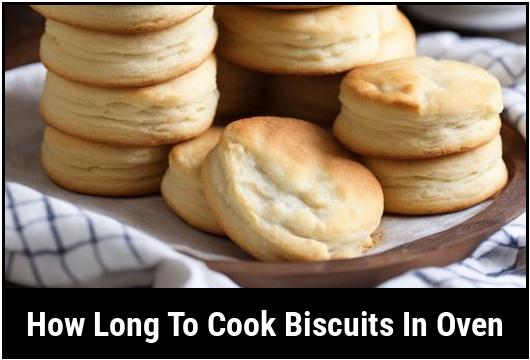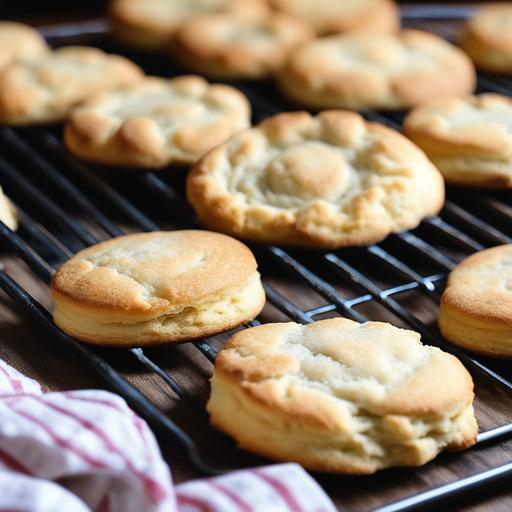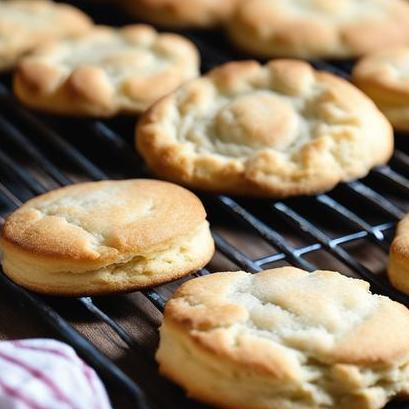[GUIDE] How Long To Cook Biscuits In Oven

Biscuits are a classic comfort food enjoyed by many. Whether you’re making them from scratch or using a store-bought mix, knowing how long to cook biscuits in the oven is crucial to achieving the perfect result. In this comprehensive guide, we’ll explore the science of cooking biscuits, discuss different cooking techniques, and provide step-by-step instructions for baking biscuits. Additionally, we’ll cover troubleshooting tips, variations to spice up your biscuits, and offer best practices to ensure your biscuits turn out light, fluffy, and delicious.
Quick Answer: How Long To Cook Biscuits In Oven
The average cooking time for biscuits in the oven is approximately 10-15 minutes at a temperature of 425°F (220°C). However, this can vary based on factors like the size and thickness of the biscuits, the type of oven you’re using, and your desired level of browning. It’s essential to monitor the biscuits closely during the cooking process to avoid over or undercooking.
Key Takeaways
- The average baking time for biscuits is 10-15 minutes at 425°F (220°C).
- Factors like biscuit size, thickness, and desired level of browning can affect cooking time.
- Monitor biscuits closely to avoid over or undercooking.
- Use the toothpick test to check for doneness.
- Different cooking techniques, such as baking on a sheet pan or in a cast-iron skillet, can yield slightly different results.
- Follow the instructions on your biscuit mix package for specific guidance.
The Science Of Cooking Biscuits

Understanding the science behind baking biscuits can help you achieve the perfect texture and rise. Biscuits rise due to a combination of leavening agents and steam formation. The leavening agents, usually baking powder and/or baking soda, release bubbles of carbon dioxide when exposed to heat. These gas bubbles expand, causing the dough to rise and create a light, airy texture.
Additionally, the heat from the oven turns the liquid in the dough into steam. This steam creates pockets within the biscuit, further contributing to its fluffiness. The combination of leavening agents and steam formation is what gives biscuits their characteristic height and tender crumb.
Choosing Biscuits
When it comes to choosing biscuits, you have two main options: homemade or store-bought mix. Homemade biscuits offer the flexibility to customize the ingredients and flavors to your liking, but they require a bit more effort. Store-bought biscuit mixes, on the other hand, offer convenience but may contain additional preservatives or additives.
If you opt for a store-bought mix, make sure to check the packaging for specific cooking instructions and recommendations. Different brands may have slightly different cooking times and temperature suggestions, so it’s essential to follow their guidelines for the best results.
Preparing Biscuits

Before you start cooking biscuits, it’s important to prepare the dough properly. Here’s a step-by-step guide on how to prepare biscuit dough:
- Gather your ingredients: You’ll typically need flour, baking powder, salt, fat (such as butter or shortening), and a liquid (such as milk or buttermilk) to make biscuits.
- Measure and combine dry ingredients: In a mixing bowl, whisk together the flour, baking powder, and salt until well combined.
- Cut in the fat: Add the fat (cold and solid) to the dry ingredients. Use a pastry cutter or your fingertips to cut the fat into the flour mixture until it resembles coarse crumbs.
- Add the liquid: Make a well in the center of the dry ingredients and pour in the liquid. Stir gently with a fork or wooden spoon until the dough comes together. Be careful not to overmix, as this can result in tough biscuits.
- Knead the dough: Transfer the dough to a lightly floured surface and gently knead it a few times to bring it together. Avoid excessive kneading, as it can also lead to tough biscuits.
- Shape the biscuits: Flatten the dough to a thickness of about 1 inch (2.5 cm) and use a round biscuit cutter or a drinking glass to cut out individual biscuits. Place them on a baking sheet lined with parchment paper or a silicone mat, leaving some space between each biscuit.
- Optional: Brush the tops of the biscuits with melted butter or milk for added flavor and browning.
Ideal Cooking Temperature For Biscuits
The ideal cooking temperature for biscuits is 425°F (220°C). This temperature allows for proper rising and browning without overcooking the biscuits. Preheating the oven is important to ensure consistent heat distribution and achieve the desired texture and doneness.
Biscuits Cooking Time

The average cooking time for biscuits is 10-15 minutes. However, the actual cooking time can vary based on several factors:
- Biscuit size: Smaller biscuits will cook faster than larger ones.
- Biscuit thickness: Thicker biscuits will require a slightly longer cooking time to ensure they are fully cooked in the center.
- Oven type: Different types of ovens (conventional, convection, etc.) may have variations in the cooking time. It’s always best to refer to your specific oven’s manual for guidance.
- Desired level of browning: If you prefer a golden brown color, you may need to extend the cooking time by a few minutes. Keep a close eye on the biscuits to prevent them from becoming too dark.
Cooking Techniques
There are a few different cooking techniques you can try to achieve slightly different results when baking biscuits:
- Baking on a sheet pan: This is the most common method and involves placing the biscuits on a sheet pan lined with parchment paper or a silicone mat. It allows for even heat distribution and yields biscuits with a golden brown bottom.
- Baking in a cast-iron skillet: Baking biscuits in a preheated cast-iron skillet can give them a slightly crispier bottom and a rustic appearance. This method is particularly popular for Southern-style biscuits.
- Baking in a muffin tin: Using a greased muffin tin can produce biscuits with taller sides and a more uniform shape. The sides of the muffin tin help support the biscuits as they rise, resulting in a distinct shape.
- Drop biscuits: If you’re short on time or prefer a more rustic-style biscuit, you can simply drop spoonfuls of dough onto the baking sheet without shaping them. This technique will yield biscuits with a more irregular shape but equally delicious taste.
Monitoring And Troubleshooting

To ensure your biscuits turn out perfectly, it’s important to monitor them closely during the cooking process. Here are some tips and troubleshooting techniques to help you achieve the desired results:
- Use the toothpick test: Insert a toothpick or skewer into the center of a biscuit to check for doneness. If it comes out clean or with a few moist crumbs, the biscuits are ready. If there is raw dough sticking to the toothpick, extend the cooking time in increments of 1-2 minutes.
- Rotate the baking sheet: About halfway through the cooking time, rotate the baking sheet 180 degrees to ensure even browning. Ovens can have hot spots, and rotating the sheet will help achieve consistent results.
- Avoid opening the oven door excessively: Opening the oven door during the cooking process can cause temperature fluctuations and affect the rise and texture of the biscuits. It’s best to check on them through the oven window or only open the door when necessary.
- Adjust cooking time for different biscuit sizes: If you’re cooking biscuits of different sizes on the same baking sheet, consider removing smaller biscuits earlier to prevent overcooking while larger biscuits finish.
- Keep an eye on browning: If the biscuits are browning too quickly but still need more time to cook, tent the baking sheet with aluminum foil to slow down the browning process.
Biscuits Cooking Instructions
To cook biscuits in the oven, follow these step-by-step instructions:
- Preheat your oven to 425°F (220°C).
- Place the prepared biscuit dough on a baking sheet lined with parchment paper or a silicone mat. Make sure to leave some space between each biscuit to allow for rising.
- Optional: Brush the tops of the biscuits with melted butter or milk for added flavor and browning.
- Place the baking sheet in the preheated oven on the center rack.
- Set a timer for the average cooking time of 10-15 minutes.
- Monitor the biscuits closely, looking for a golden brown color and using the toothpick test to check for doneness.
- Once the biscuits are cooked to your desired level, remove them from the oven.
- Allow the biscuits to cool slightly before serving. Enjoy warm or at room temperature.
Variations

While traditional biscuits are delicious on their own, you can experiment with various additions and flavors to create unique biscuit variations. Here are some ideas to inspire your creativity:
- Cheesy biscuits: Add shredded cheese, such as cheddar or parmesan, to the biscuit dough for a gooey and savory twist.
- Herb-infused biscuits: Incorporate dried or fresh herbs like rosemary, thyme, or parsley into the dough to enhance the flavor profile.
- Sweet biscuits: Add a touch of sugar and vanilla extract to the dough for a slightly sweet treat. These are particularly delightful when topped with a drizzle of glaze or served with jam.
- Whole-grain biscuits: Substitute some or all of the all-purpose flour with whole-grain flour, such as whole wheat or oat flour, for a heartier and nuttier flavor.
- Stuffed biscuits: Roll out the biscuit dough, place a filling like cheese, ham, or jam in the center, then fold and seal the dough before baking.
Feel free to get creative and experiment with different flavors and ingredients.
Pro Tip: When adding extra ingredients to the biscuit dough, make sure not to overload it. Excessive additions can weigh down the dough and affect the rise and texture of the biscuits.
When Things Go Wrong
Even with careful preparation and monitoring, things can sometimes go awry. Here are some common issues that may arise when baking biscuits and possible solutions:
- Flat biscuits: If your biscuits turn out flat and dense, it may be due to your leavening agents being expired or not properly measured. Ensure that your baking powder and baking soda are fresh and accurately measured using level spoons.
- Tough biscuits: Overmixing the dough or kneading it too much can result in tough biscuits. Handle the dough gently and avoid excessive mixing or kneading.
- Dry biscuits: Biscuits can become dry if you overbake them or use too much flour in the dough. Follow the recommended cooking time and use the precise amount of flour specified in the recipe.
- Burnt bottoms: If the bottoms of your biscuits are getting too brown or burnt before the tops are fully cooked, consider adjusting the oven rack position. Placing the baking sheet on a higher rack in the oven can help prevent excessive browning on the bottom.
- Uneven browning: If the biscuits are browning unevenly, it may be due to hot spots in your oven. Rotating the baking sheet halfway through the cooking time can help achieve more consistent browning.
Remember that practice makes perfect, and don’t be discouraged by a few missteps. Learning from these experiences will help you improve your biscuit baking skills over time.
Serving Biscuits

Biscuits can be enjoyed in various ways, depending on your preferences. Here are some serving suggestions:
- Fresh out of the oven: Biscuits are often best enjoyed warm, straight out of the oven. Serve them with butter, jam, or honey for a simple yet satisfying treat.
- With gravy: Biscuits and gravy make for a popular breakfast or brunch combination. Top split biscuits with creamy sausage or vegetarian gravy for a hearty and comforting meal.
- As a side dish: Biscuits are a fantastic accompaniment to savory meals like soups, stews, or roasted meats. They can be used to mop up sauces or to add a touch of breadiness to your main course.
- In sandwiches: Split biscuits can also be used as the base for sandwiches. Fill them with your favorite ingredients, such as ham and cheese, chicken salad, or fried chicken, for a tasty and portable meal.
Best Practices For Biscuits Cooking
To ensure consistently delicious biscuits every time, here are some best practices to keep in mind:
- Follow the recipe: When making biscuits from scratch, it’s crucial to follow the recipe instructions and measurements precisely. Baking is a science, and even slight deviations can affect the final result.
- Use fresh leavening agents: Check the expiration dates on your baking powder and baking soda before using them. Expired leavening agents may not provide sufficient rise and could impact the texture of the biscuits.
- Handle the dough gently: Overmixing or kneading the dough excessively can result in tough biscuits. Handle the dough gently and only mix until it just comes together.
- Preheat the oven: Make sure to preheat your oven to the recommended temperature before placing the biscuits inside. This allows for even baking and consistent results.
- Avoid overcrowding: Give the biscuits some space on the baking sheet to ensure they can rise properly without touching each other. Overcrowding can lead to biscuits merging together during baking.
- Adjust cooking time if needed: Factors like biscuit size, thickness, and personal preference can affect the cooking time. Be prepared to adjust the cooking time accordingly and use the toothpick test to check for doneness.
- Practice and learn from experience: Baking biscuits, like any skill, improves with practice. Be patient, take note of what works well and what can be improved upon, and keep experimenting to find the perfect biscuit recipe and technique for your taste.
Conclusion
Knowing how long to cook biscuits in the oven is crucial to achieving the perfect texture and taste. By understanding the science behind biscuit baking, choosing the right ingredients, properly preparing the dough, and following the recommended cooking techniques, you can bake light, fluffy, and delicious biscuits every time. Experiment with variations, troubleshoot common issues, and follow best practices for biscuit baking success. So go ahead, preheat that oven, and enjoy the delightful aroma and taste of freshly baked biscuits.
FAQS
How Long Should I Bake Biscuits In The Oven?
Typically, biscuits should be baked for around 12-15 minutes in the oven. However, the exact baking time may vary based on several factors, including the recipe, the oven temperature, and the size of the biscuits.
What Temperature Should I Set My Oven To When Baking Biscuits?
The optimal oven temperature for baking biscuits is usually between 375-425 degrees Fahrenheit. However, this may also vary depending on the recipe you are using.
How Can I Tell If My Biscuits Are Done Baking?
You can tell if your biscuits are done baking by checking their color and texture. Biscuits that are golden brown on the outside and fluffy on the inside are usually fully cooked. You can also perform a "toothpick test" by inserting a toothpick into the center of the biscuit. If it comes out clean, your biscuits are likely done.
Can I Use A Convection Oven To Bake Biscuits?
Yes, you can use a convection oven to bake biscuits. However, you may need to adjust the baking time and temperature accordingly since convection ovens circulate hot air more efficiently, resulting in faster and more even cooking.
Should I Use A Baking Sheet Or Parchment Paper When Baking Biscuits In The Oven?
It is recommended to use a baking sheet or parchment paper when baking biscuits in the oven to prevent them from sticking and to help distribute heat evenly. Make sure to lightly grease or flour the baking sheet before placing the biscuits on it to avoid any sticking issues.
Sources
About the Author Jenny
I'm Jenny, a housewife with an unwavering passion for food. My culinary journey began with my grandmother's kitchen, and it's now a full-fledged food blog. I've turned my love for cooking into a creative outlet, sharing recipes and stories with a global community of fellow food enthusiasts. It's proof that being a housewife can also mean pursuing your passions and savoring life's delectable moments.
